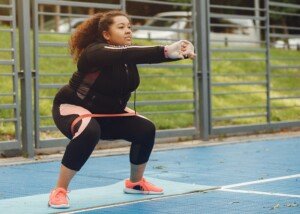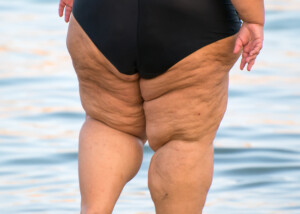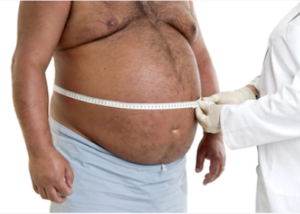If you’re at least 100 lbs. overweight (morbidly obese), here are 10 exercises that you should avoid, because gravity is a real thing.
This list by no means leaves you with few options for exercise.
But it’s a very important list of exercises to avoid if you’re very overweight – due to safety concerns.
Certain exercises can pose risks due to excessive stress on joints, increased risk of injury and potential for exacerbating existing health conditions.
Here are 10 exercises that are generally not safe for obese individuals, along with explanations of the risks involved.
1 Jogging
Jogging can place excessive strain on the knees, hips and lower back due to the high impact of each step.
This can lead to joint pain, arthritis and other musculoskeletal issues.
Though there are those with moderate obesity who jog, morbid obesity is a deal breaker.
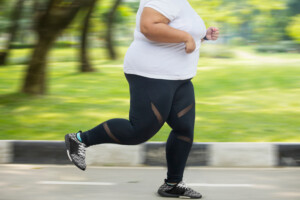
Shutterstock/Creativa Images
There’s no reason for someone who’s at least 100 pounds too heavy to go jogging, whether their primary goal is weight loss or whether it’s more stamina or better heart health.
Brisk walking will produce some good panting while being safer to the knees.
2 Jumping Jacks or Similar
Jumping jacks involve repetitive jumping motions that can be hard on the joints, especially the knees.
The high-impact nature of this exercise can increase the risk of injury and joint pain for obese individuals.
3 Box Stepping
Believe it or not, I’ve more than once witnessed personal trainers having overweight people stepping onto and off either a 12 inch exercise stool or a standard weightlifting bench.
I think I’ve even seen the client holding dumbbells.
High stepping just is not necessary for even moderately obese people, no matter what their goals.
This can stress the knees, and there’s also balance to consider.
When someone is significantly overweight, their balance is thrown off-kilter due to the unnatural distribution of mass on their body.
They are thus more prone to losing balance as they’re stepping onto, as well as lowering from, the platform.
4 Mountain Climbers
Mountain climbers are a high-intensity exercise that involves rapidly alternating knee drives while in a plank position.
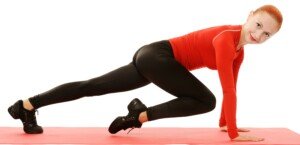
Freepik.com/nikitabuida
This can put a lot of stress on the wrists, shoulders and lower back, and the fast pace – or attempt at a fast pace – increases the likelihood of improper form and subsequent injury.
5 High-Impact Aerobics
High-impact aerobics involve a lot of jumping, hopping and rapid movements that can be hard on the joints.
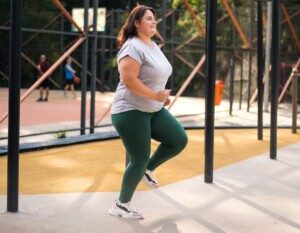
Freepik/frimufilms
The continuous high-impact activity can exacerbate joint pain and increase the risk of injuries.
Plus, because an obese person may have a significant amount of excess frontal body weight, this forward-extending mass can throw them off-balance, resulting in a fall.
6 Step Aerobics
Step aerobics involve stepping up and down on a raised platform, which can be problematic for very fat people.
The repetitive stepping motion can strain the knees and ankles, leading to potential injuries.
In addition, many step classes involve pivoting and turning on the stepper.
A very hefty individual can be thrown off-balance and end up falling.
7 Deep Squats
Deep squats require a significant range of motion in the hips and knees.
For morbidly obese individuals, the extra body weight can put additional pressure on these joints, leading to pain and potential damage, particularly if the exercise is performed with improper form.
In fact, it’s very likely there will be incorrect form, as their large size may cause their body to list or tilt as they go up and down with the squatting.
They may not even be aware of this side-leaning.
They may also end up favoring a leg and not even realize this, either.
There’s no reason for a significantly overweight man or woman to attempt deep squats, even if it’s without holding weights.
8 Lunges
Lunges place a lot of stress on the knees and require good balance and coordination.
The forward motion and weight distribution can be challenging for obese individuals, increasing the risk of knee pain and injury.
Don’t even think about lunges, despite how hyped up they are.
I’ve seen plenty of thin people do stationary and walking lunges wrong.
A common mistake is a forward lean with a rounded back, which places extra stress on the lower back.
The spine should be upright, as perpendicular to the floor as possible.
I’ve also seen non-overweight people wobble as they do walking lunges.
The additional mass of obesity will make bad form almost guaranteed.
9 Pushups, even Modified
Forget it. There’s absolutely no reason in the universe why any obese person should “work on” pushups, even off their knees.
Never mind if you’ve seen personal trainers having their fat clients do half-baked pushups off their knees or partial range-of-motion pushups off their toes.
This seems to be a trainer’s ego thing, as though the trainer wants gym members to see that they’ve got a very hefty person actually doing pushups.
All the extra weight puts a very heavy individual at high risk for shoulder tendon injury. Very high.
If you want to work your chest and arm muscles, for Pete’s sake, use a machine, a barbell or dumbbells.
10 Dips
Why would a very heavy person want to do dips? Well, curiosity could get the best of them.
It could also be an issue of thinking that if they could train their body to perform this movement, it’ll bring a sense of accomplishment.

Freepik
A person with over a hundred pounds of excess weight won’t be able to do unassisted parallel bar dips, nor will they be able to perform bench dips with their legs straight, even if their feet are on the floor.
It’ll be very difficult for a 250 pound, 5’7 woman to train her body to perform a full range of motion dip off a bench, with her legs straight and heels on the floor. Same for a morbidly obese man.
If she bends her legs enough, she can lower so that her upper arms are parallel with the floor, but then, her legs will be assisting quite a bit – so this won’t be a true dip.
Even though men are naturally stronger, in terms of baseline, than women, a morbidly obese man will struggle as much as will a very large woman when it comes to the bench dip. It’s a tough exercise even for thin beginners.
In the process of attempting to achieve a full range of motion, after weeks and weeks and weeks of struggling, a severely obese person will be at very high risk for a rotator cuff tendon injury.
The dip assist machine can be used, but the assist will need to be quite a bit of weight.
There’s just no point. If a very heavy man or woman wants to work the triceps, they can do this safely and with less frustration via triceps machines, pulley machines, dumbbells and tension bands.
Attempting dips with a hundred pounds of excess fat is begging for shoulder tendon injury.
Safety Considerations and Alternative Exercises
- Walking: A low-impact, accessible form of cardio that can be easily modified to fit the individual’s fitness level.
- Cycling: Stationary or outdoor cycling can improve cardiovascular health without the impact of running.
- Pedaling machines. Any pedaling machine is appropriate for morbid obesity.
- Low impact aerobics. Many gyms offer a variety of slower, less-impacting classes.
- Swimming laps: Provides a full-body workout without placing stress on the joints, as the water supports the body weight. Note: Sustained lap swimming can be difficult and isn’t for everyone.
- Resistance bands: Tension bands are gentle on the joints when used with proper form.
- Strength training machines and cable equipment. These offer a vast amount of exercise options including pulling movements such as the seated row (not the aerobic rower, but pulling a weight stack), the pull-down from above, chest and shoulder machines, and the leg press, leg curl and leg extension machines.
- Barbell and dumbbell work. This can include the flat and incline press, and the bent-over dumbbell row.
Monitoring and Progression
- Start Slow: Begin with short, manageable workouts and gradually increase duration and intensity as fitness improves.
- Focus on Form: Ensure exercises are performed with proper technique to minimize the risk of injury.
- Listen to the Body: Pay attention to your body and avoid pushing through pain, which can lead to injuries.


